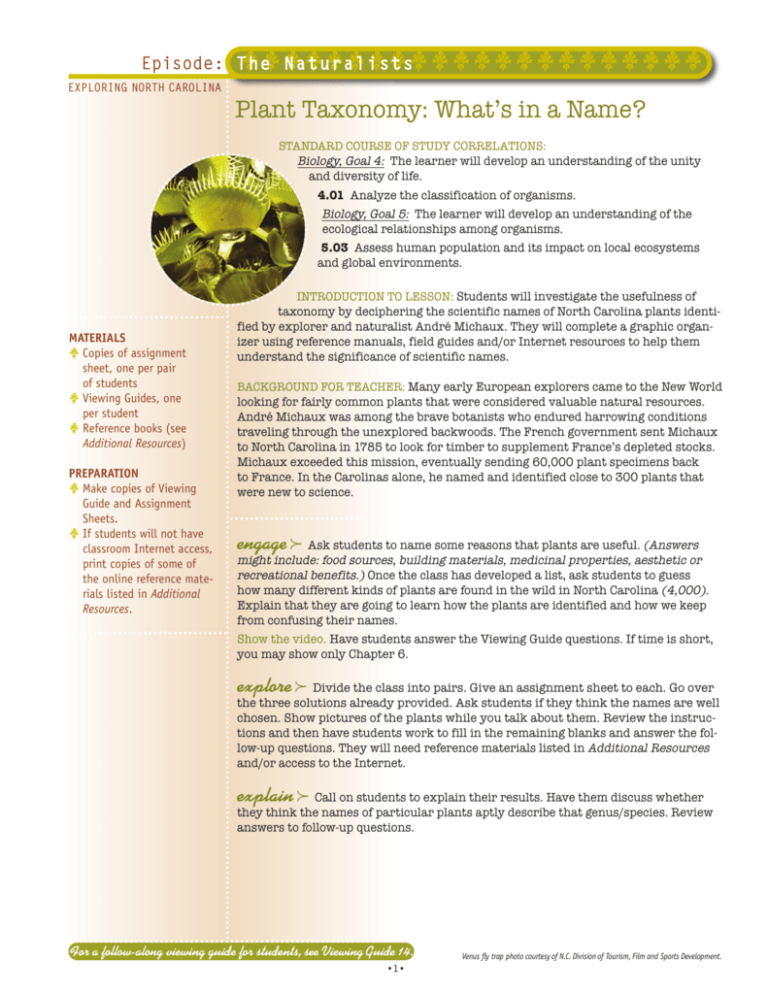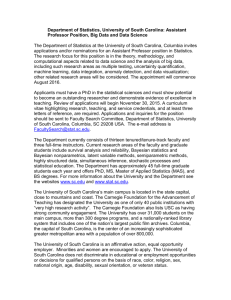Plant Taxonomy: What's in a Name?
advertisement

wwwwwwwwwwwwwwwwwwwwww Episode: The Naturalists EXPLORING NORTH CAROLINA Plant Taxonomy: What’s in a Name? STANDARD COURSE OF STUDY CORRELATIONS: Biology, Goal 4: The learner will develop an understanding of the unity and diversity of life. 4.01 Analyze the classification of organisms. Biology, Goal 5: The learner will develop an understanding of the ecological relationships among organisms. 5.03 Assess human population and its impact on local ecosystems and global environments. MATERIALS w Copies of assignment sheet, one per pair of students w Viewing Guides, one per student w Reference books (see Additional Resources) PREPARATION w Make copies of Viewing Guide and Assignment Sheets. w If students will not have classroom Internet access, print copies of some of the online reference materials listed in Additional Resources. INTRODUCTION TO LESSON: Students will investigate the usefulness of taxonomy by deciphering the scientific names of North Carolina plants identi­ fied by explorer and naturalist André Michaux. They will complete a graphic organ­ izer using reference manuals, field guides and/or Internet resources to help them understand the significance of scientific names. BACKGROUND FOR TEACHER: Many early European explorers came to the New World looking for fairly common plants that were considered valuable natural resources. André Michaux was among the brave botanists who endured harrowing conditions traveling through the unexplored backwoods. The French government sent Michaux to North Carolina in 1785 to look for timber to supplement France’s depleted stocks. Michaux exceeded this mission, eventually sending 60,000 plant specimens back to France. In the Carolinas alone, he named and identified close to 300 plants that were new to science. engage f Ask students to name some reasons that plants are useful. (Answers might include: food sources, building materials, medicinal properties, aesthetic or recreational benefits.) Once the class has developed a list, ask students to guess how many different kinds of plants are found in the wild in North Carolina (4,000). Explain that they are going to learn how the plants are identified and how we keep from confusing their names. Show the video. Have students answer the Viewing Guide questions. If time is short, you may show only Chapter 6. explore f Divide the class into pairs. Give an assignment sheet to each. Go over the three solutions already provided. Ask students if they think the names are well chosen. Show pictures of the plants while you talk about them. Review the instruc­ tions and then have students work to fill in the remaining blanks and answer the fol­ low-up questions. They will need reference materials listed in Additional Resources and/or access to the Internet. explain f Call on students to explain their results. Have them discuss whether they think the names of particular plants aptly describe that genus/species. Review answers to follow-up questions. For a follow-along viewing guide for students, see Viewing Guide 14. •1• Venus fly trap photo courtesy of N.C. Division of Tourism, Film and Sports Development. Plant Taxonomy: What’s in a Name? wwwwwwwww BEYOND THE CLASSROOM Plan an expedition to look for Michaux’s plants on the school grounds or at a local garden or park. Students might pre­ tend they are adventurers like Michaux and keep a journal of the plants they discover. Additional Resources: e (Magnolia fed magnolia tre ered the large lea courtesy of Larry Allain, ov sc di x au ch André Mi otograph Stanley, N.C. Ph macrophylla) in arch Center. se Re s nd tla We USGS National elaborate f Have students complete at least one of the following exercises and present their findings to the class in a creative format: • Make up scientific names suitable for invented plants and explain the reasons for choosing them. • Work up a thorough profile of a North Carolina plant species, including its com­ plete taxonomic classification (from phylum through species), proper growing conditions, horticultural or medicinal uses and any other important attributes. • Further investigate the life and work of André Michaux. evaluate f Use the key to evaluate the students’ work. In some cases, the genus name is identical to the meaning of the Latin word (e.g., Salix means “willow”). Allow for variation in interpretation—for example, students may find slightly different descriptions of word roots (e.g., “big” instead of “large”). Teacher’s Notes: Many biology texts have a word root appendix. Dictionar­ ies, including those online, usually contain the Latin or Greek roots of words. Flower and tree field guides may also be useful. Dictionary of Plant Names. Coombes, Allen J. 1999. Port­ land, Ore.: Timber Press. Wildflowers of North Carolina, 2nd Edition. Justice, William S., C. Ritchie Bell and Anne H. Lindsay. 2005. Chapel Hill, N.C.: UNC Press. Gardener’s Latin. Neal, Bill. 1992. Chapel Hill, N.C.: Algonquin Books. http://www.michaux.org/ • An encyclopedic reference on Michaux’s life and work. http://www.ncwildflower.org/ index.php/plants • North Car­ olina Native Plant Society’s image gallery of North Carolina plant species, indexed alpha­ betically. http://www.duke.edu/ ~jspippen/plants/plants.htm • Multiple views of North Carolina plant species, includ­ ing wildflowers, shrubs, trees and vines. http://www.ces.ncsu.edu/ depts/hort/consumer/ pgpages.html • Index of pub­ lic gardens in North Carolina. http://botanicallatin.org/ botnamemean.html • Indepth explanation of how Latin is used in scientific names. wwwwwwwww •2• Plant Taxonomy: What’s in a Name? Assignment Plant Taxonomy: What’s in a Name? This table contains the common and scientific names of 20 North Carolina plants identified and named by André Michaux (including one plant named to honor him). First, decipher the meaning of the scientific names of these plants. Next, examine pictures and descriptions of these plants to decide whether you think Michaux did a good job of naming them. Your teacher will provide reference materials. Finally, answer the follow-up questions about the classification of organisms. Common name Scientific name Bigleaf magnolia Magnolia macrophylla Blue cohosh Caulophyllum thalictroides Carolina lily Lilium michauxii Carolina rhododendron Rhododendron minus Catawba rhododendron Rhododendron catawbiense Cherokee rose Rosa laevigata Christmas fern Polystichum acrostichoides Crab-apple Malus angustifolia Fever-tree Pinckneya pubens Flame azalea Rhododendron calendulaceum Longleaf milkweed Asclepias longifolia Meaning of scientific name Good name? Y/N (Give reason) Cabbage-leaf; similar to meadow rue (Thalictrum). Named for Charles Pinckney (friend of Michaux); downy leaves. continued on next page •3• Plant Taxonomy: What’s in a Name? Plant Taxonomy: What’s in a Name? continued Common name Scientific name Muscadine Vitis rotundifolia Pond pine Pinus serotina Southern red oak Quercus falcata Meaning of scientific name Good name? Y/N (Give reason) Oak; sickle-shaped leaf tips. Spear-leafed yellow violet Viola hastata Sedum ternatum Swamp willow Salix caroliniana Trillium Trillium grandiflorum Umbrella-leaf Diphylleia cymosa Wild ginger or heartleaf Hexastylis arifolia follow-up questions Stonecrop 1. What two classification categories make up a scientific name? 2. Why did Michaux give the plants scientific names; that is, why didn’t he simply use their common (informal) names? 3. In some cases, the scientific name and the common name are the same (such as Trillium/ trillium and Magnolia/magnolia). Why do you think this is so? 4. Is the flame azalea more closely related to the Catawba rhododendron or to the fever-tree? How can you tell? 5. Which plant do you think is the best example of a well-chosen scientific name? Why? Which plant do you think is the best example of a poorly chosen scientific name? Why? 6. Do you think that Michaux accomplished his mission for the French government? Explain. •4• answer key Plant Taxonomy: What’s in a Name? Scientific name Meaning of scientific name Bigleaf magnolia Magnolia macrophylla Named for Pierre Magnol (French botanist); large leaves. Blue cohosh Caulophyllum thalictroides Cabbage-leaf; similar to meadow rue (Thalictrum). Carolina lily Lilium michauxii Lily; named for Andre´ Michaux. Carolina rhododendron Rhododendron minus Red + tree; smaller leaves. Catawba rhododendron Rhododendron catawbiense Red + tree; Catawba River. Cherokee rose Rosa laevigata Rose; smooth, polished. Christmas fern Polystichum acrostichoides Many rows (spore cases); lined out to the tip. Crab-apple Malus angustifolia Apple; narrow-leaved. Fever-tree Pinckneya pubens Named for Charles Pinckney (friend of Michaux); downy leaves. Flame azalea Rhododendron calendulaceum Red + tree; like an orange-gold flower (calendula). Longleaf milkweed Asclepias longifolia Greek god of medicine; long-leaved. Muscadine Vitis rotundifolia Grape vine; round-leaved. Pond pine Pinus serotina Pine; late (seeds need fire to open). Southern red oak Quercus falcata Oak; sickle-shaped leaf tips. Spear-leafed yellow violet Viola hastata Violet; like a spearhead. Stonecrop Sedum ternatum Sedum (to sit); in threes. Swamp willow Salix caroliniana Willow; found in Carolina. Trillium Trillium grandiflorum Three; large flowers. Umbrella-leaf Diphylleia cymosa Two leaves; flattened flower heads. Wild ginger or heartleaf Hexastylis arifolia Six styles; leaves like Arum leaves. follow-up questions Common name 1. Which two classification categories make up a scientific name? Genus and species. 2. Why did Michaux give the plants scientific names; that is, why didn’t he simply use their common (informal) names? Scientific names are universal; common names can be confusing because they may apply to more than one species. 3. In some cases, the scientific name and the common name are the same (such as Trillium/trillium and Magnolia/magnolia). Why do you think this is so? There is no commonly known name for some genera (plural of genus). 4. Is the flame azalea more closely related to the Catawba rhododendron or to the fever-tree? How can you tell? The flame azalea is more closely related to the Catawba rhododendron because they share the same genus. 5. Which plant do you think is the best example of a well-chosen scientific name? Why? Which plant do you think is the best example of a poorly chosen scientific name? Why? Answers will vary. 6. Do you think that Michaux accomplished his mission for the French government? Explain. Answers may vary. Michaux didn’t find any tree species practical for ship masts, for example, but he discov­ ered many other species with desirable uses (e.g., muscadine to make wine). •5•








